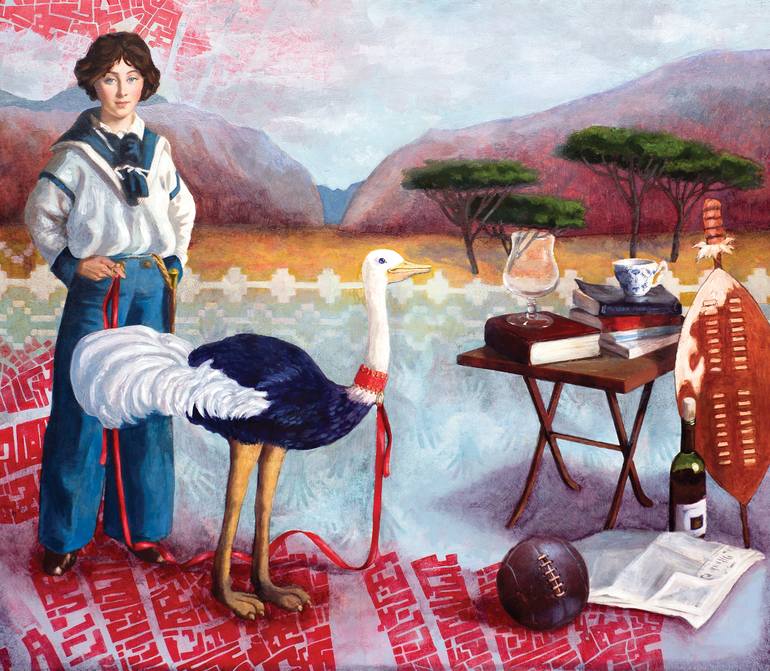


VIEW IN MY ROOM
Florence Dixie 1855 – 1905 Painting
United Kingdom
Painting, Oil on Wood
Size: 27.5 W x 24 H x 2 D in
About The Artwork
Oil & mixed media on gesso board Lady Florence Dixie (née Douglas), was a Scottish traveller, war correspondent, writer and feminist. She wrote an account of travelling ‘Across Patagonia’, ‘Land of Misfortune’ covering the Zulu Wars, and many books which deal with feminist themes. Florence was an unconventional child whose early years, shaped by her close relationship with her twin brother, were spent in a tumble of competitive physical activities. At only five foot tall and wearing her hair short, she was noted for being “fearless, dynamic and opinionated”. As an adult she advocated equality for the sexes in marriage and divorce, and proposed women should be able to wear the same clothes as men. In December 1878, Dixie and her husband led an expedition to Patagonia, chosen because supposedly few European men, and no European women, had ever set foot there. She played an active role in the party, hunting game (including ostriches) for food. In her subsequent writing ‘Across Patagonia’, Dixie never actually mentions her husband by name, presenting herself as the hero of the expedition. Generally considered to have had a happy marriage despite the reduced circumstances that ensued from her husband’s drinking and gaming debts, the couple were reportedly referred to by contemporaries as “Sir Always and Lady Sometimes Tipsy”. In 1879 she gained a commission as war correspondent for The Morning Post to cover the Zulu Wars in South Africa, but arriving too late, she justified her visit by interviewing the defeated King Cetswayo. Impressed by his dignity she returned home to successfully campaign for his reinstatement. Scandal surrounded her in 1883 when an attack on her person (supposedly by two ‘Fenian’ men dressed as women) was brought into question. Beatrix Potter commented on it in her journals thus “Some of the papers, this being a sceptical age and the lady a Tory, have tried to make out that the affair never happened, but I think there are the strongest reasons and evidence that it did....she must be a lively and extraordinary person, much more like a man, strong headed, but brave and sound hearted.” Queen Victoria at nearby Windsor Castle sent her ghillie John Brown to investigate. Sadly he caught a chill and died, causing the Queen to blame Florence for his demise. In 1890, Dixie published a utopian novel, Gloriana, in which she rails against a patriarchal society “Nature has unmistakably given to woman a greater brain power... Yet man deliberately sets himself to stunt that...laying down the law that woman’s education shall be on a lower level... this procedure is arbitrary and cruel....It has been the means of sending to their graves unknown, unknelled, and unnamed, thousands of women whose high intellects have been wasted, and whose powers for good have been paralysed and undeveloped.” A keen sports woman throughout her life, Dixie became President of the British Ladies’ Football Club in 1895. Despite enjoying blood sports in her youth, she later wrote passionately against hunting and became a committed vegetarian. Florence died of diphtheria aged 50. She is not totally uncelebrated however for her name still graces the (disappointingly remodelled) ‘Hotel Lady Florence Dixie’ in Puerto Natales, Southern Chile. Original work available through The Martin Tinney Gallery, Cardiff
Details & Dimensions
Painting:Oil on Wood
Original:One-of-a-kind Artwork
Size:27.5 W x 24 H x 2 D in
Frame:Not Framed
Ready to Hang:No
Shipping & Returns
Delivery Time:Typically 5-7 business days for domestic shipments, 10-14 business days for international shipments.
Have additional questions?
Please visit our help section or contact us.
United Kingdom
I began producing elaborate mixed media pieces while on my long stay in Venice, making use of the city-floor ephemera of discarded museum leaflets and postcards. Incorporating ‘scraps’ of the past, sourced from secondhand books and magazines, and the maps I grew up with as the child of an intrepid Geophysicist, I produced a diary of sorts, the alternative reality of a history I invented for myself. I have since developed this way of working, often inspired by current events, creating ‘intricate scenes of social malfunction’, my investigations into ‘the human condition’ through a series of imagined portraits. I studied Fine Art at Oxford Brookes University, spending my final year at The School of the Art Institute of Chicago on an extended travel award. Graduating in 1992 I moved back to London, where for a time I slipped into the world of graphic design and illustration, working for Raymond Loewy International, and subsequently becoming Course Tutor at Lambeth College, and later a lecturer at Worcester University. By the late 1990s, emboldened to pursue my painting career by formidable gallery owner and art advocate the late Elizabeth Organ, a series of events shaped my subsequent work, beginning with the move from London to unfeasibly feudal Herefordshire, a turbulent marriage in a ‘Gormenghast’ of a castle, and a subsequent period of exile in Venice. My work has most recently been shown at the Royal West of England Academy, Bristol and the Mernier Gallery, London, with an increasing following of private European collectors from Southern France to Croatia. Represented by: The Martin Tinney Gallery Cardiff http://www.artwales.com/ Gala Fine Art, Bristol http://galafineart.uk
Thousands Of Five-Star Reviews
We deliver world-class customer service to all of our art buyers.
Global Selection
Explore an unparalleled artwork selection by artists from around the world.
Satisfaction Guaranteed
Our 14-day satisfaction guarantee allows you to buy with confidence.
Support An Artist With Every Purchase
We pay our artists more on every sale than other galleries.
Need More Help?